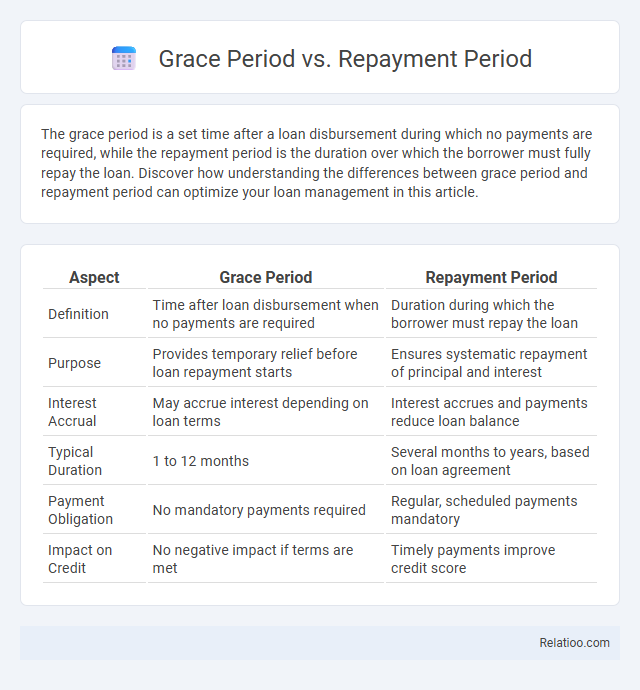The grace period is a set time after a loan disbursement during which no payments are required, while the repayment period is the duration over which the borrower must fully repay the loan. Discover how understanding the differences between grace period and repayment period can optimize your loan management in this article.
Table of Comparison
| Aspect | Grace Period | Repayment Period |
|---|---|---|
| Definition | Time after loan disbursement when no payments are required | Duration during which the borrower must repay the loan |
| Purpose | Provides temporary relief before loan repayment starts | Ensures systematic repayment of principal and interest |
| Interest Accrual | May accrue interest depending on loan terms | Interest accrues and payments reduce loan balance |
| Typical Duration | 1 to 12 months | Several months to years, based on loan agreement |
| Payment Obligation | No mandatory payments required | Regular, scheduled payments mandatory |
| Impact on Credit | No negative impact if terms are met | Timely payments improve credit score |
Understanding Grace Periods
A grace period is a designated timeframe after a loan disbursement or billing date during which you are not required to make payments, reducing immediate financial pressure. Repayment periods follow grace periods and mark the phase when regular payments toward principal and interest begin, essential for managing debt responsibly. Understanding grace periods helps you plan your budget effectively by knowing when payments start and avoiding late fees or penalties.
What Is a Repayment Period?
The repayment period is the scheduled timeframe during which you are required to make regular payments to fully repay a loan or debt. Unlike the grace period, which temporarily delays payment obligations without penalties, the repayment period officially starts once the grace period ends or the loan matures. Understanding the repayment period is crucial for managing your finances and avoiding late fees or increased interest charges.
Key Differences Between Grace and Repayment Periods
The grace period is the timeframe after loan disbursement when you are not required to make payments, allowing your finances to stabilize before repayment begins. The repayment period follows the grace period and involves actively paying back the loan principal and interest in scheduled installments. Understanding the key differences between grace and repayment periods ensures you manage your loan efficiently and avoid penalties.
How Grace Periods Affect Loan Repayment
Grace periods allow borrowers temporary relief from loan payments, delaying the start of repayments without incurring penalties or interest accumulation in some cases. This pause can improve financial flexibility, but extending the total loan duration often results in higher overall interest costs. Understanding the difference between the grace period, repayment period, and deferral options is crucial for effective loan management and minimizing long-term debt burden.
Interest Accrual: Grace Period vs Repayment Period
During the grace period, interest may or may not accrue on your loan depending on the loan type, with federal student loans typically not accruing interest, while private loans often do. In the repayment period, interest always accrues on the outstanding loan balance, increasing the total amount you owe if payments are deferred or missed. Understanding these differences helps you manage your loan effectively to minimize interest costs during both periods.
Common Types of Loans With Grace Periods
Common types of loans with grace periods include federal student loans, personal loans, and some mortgage loans, which offer a set timeframe post-disbursement during which borrowers are not required to make payments. The grace period allows temporary relief before the repayment period begins, helping borrowers manage finances without immediate payment obligations. Understanding the distinctions between grace periods and repayment periods is crucial for effective loan management and financial planning.
Pros and Cons of Grace Periods
Grace periods offer temporary relief by postponing loan repayments, allowing you to stabilize your finances before starting payments, which helps prevent immediate financial strain. However, interest often accrues during this time, increasing the overall loan cost and potentially extending the debt period. Unlike repayment periods where payments are mandatory, grace periods provide flexibility but can lead to higher long-term expenses if not managed carefully.
Transitioning from Grace Period to Repayment Period
The transition from the grace period to the repayment period marks a critical phase in managing your student loans, as it signifies when you must start making regular payments to avoid default. The grace period is a designated time after graduation, typically six months, during which you are not required to make payments, allowing you time to find employment or stabilize your finances. Understanding the exact dates and terms of both your grace and repayment periods ensures you can plan your budget effectively and maintain a positive credit history.
Managing Finances During Grace and Repayment Periods
Managing finances during grace and repayment periods entails carefully balancing cash flow to avoid missed payments and unnecessary interest accrual. The grace period offers temporary relief from payment obligations without penalties, but interest may still accrue depending on the loan terms, making budgeting crucial. During the repayment period, consistent payments reduce principal and interest, requiring disciplined financial planning to maintain credit health and minimize debt.
Frequently Asked Questions on Loan Repayment Timelines
Grace period refers to the time after a loan disbursement or graduation during which borrowers are not required to make payments, typically lasting 6 to 12 months. Repayment period is the total duration over which the loan must be fully repaid, often ranging from 5 to 20 years depending on the loan type. Frequently asked questions highlight differences such as whether interest accrues during the grace period, how payments are structured once repayment begins, and options for extending or modifying repayment timelines.

Infographic: Grace Period vs Repayment Period
 relatioo.com
relatioo.com